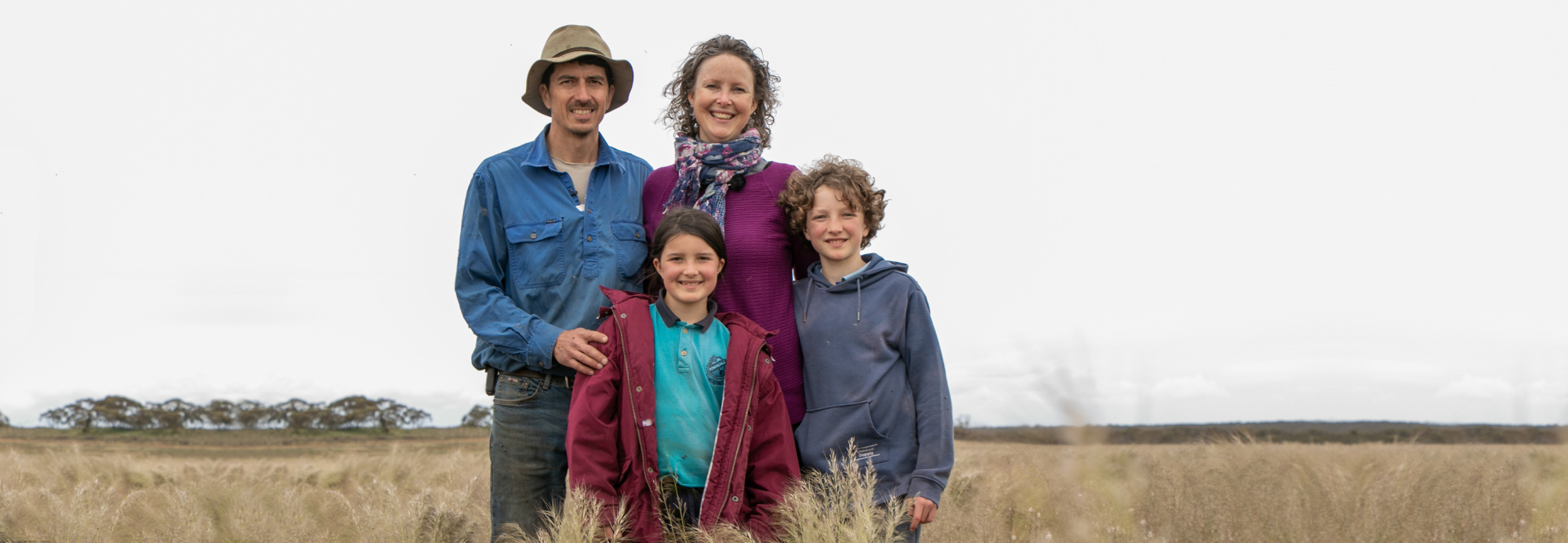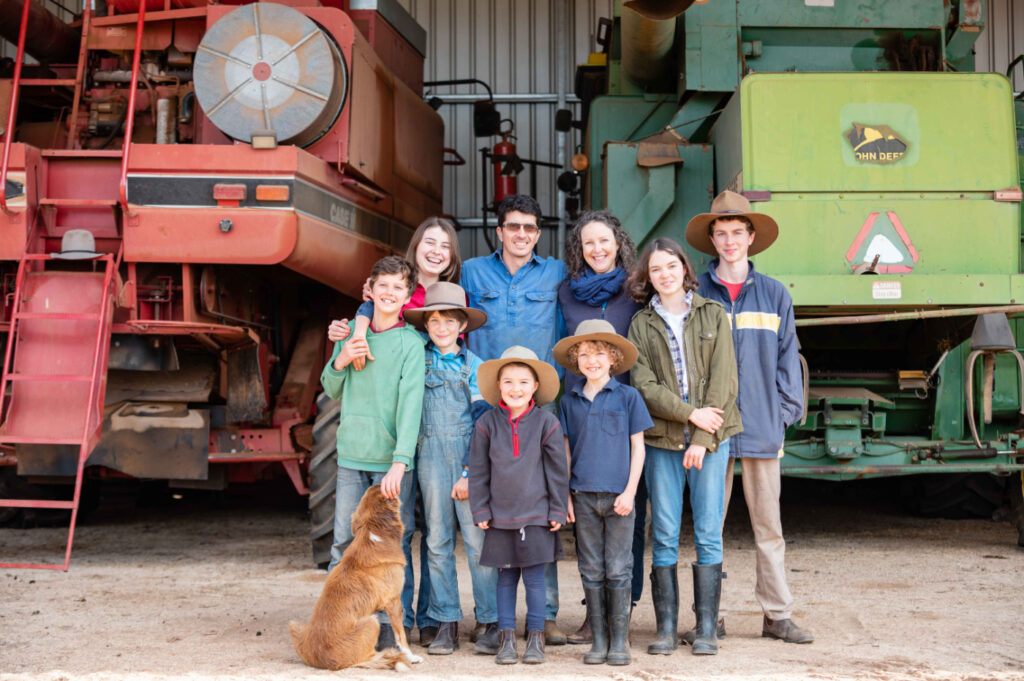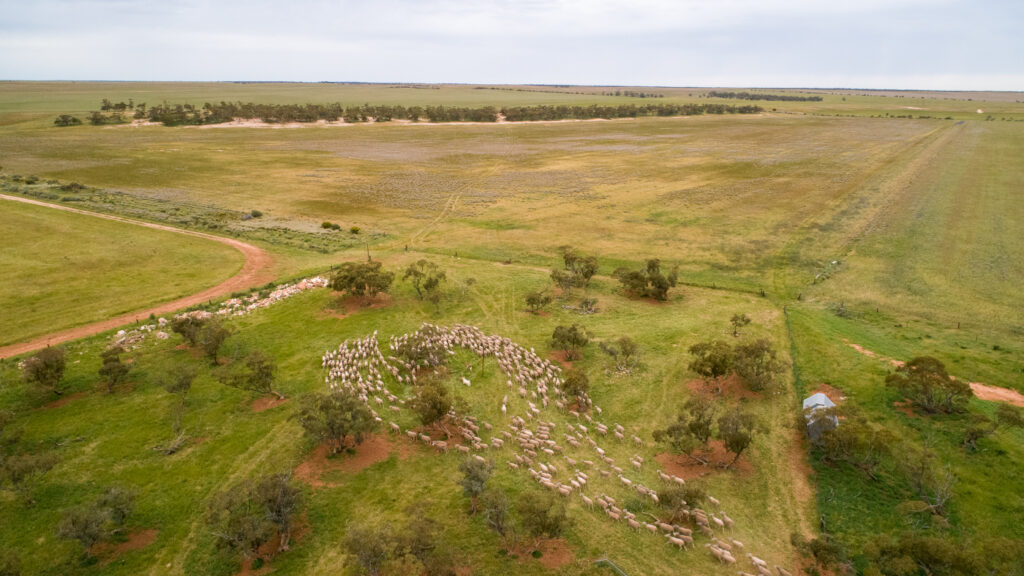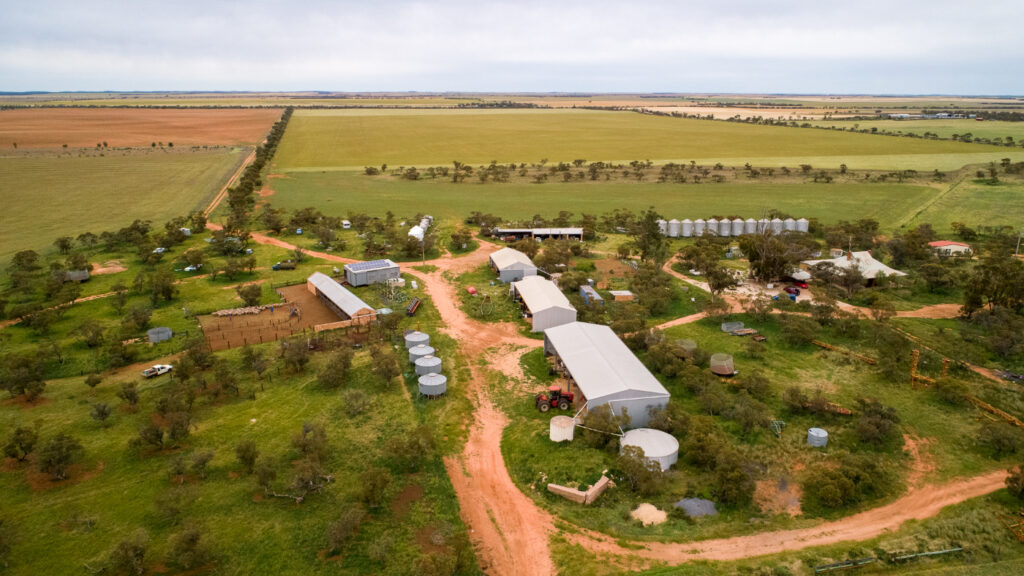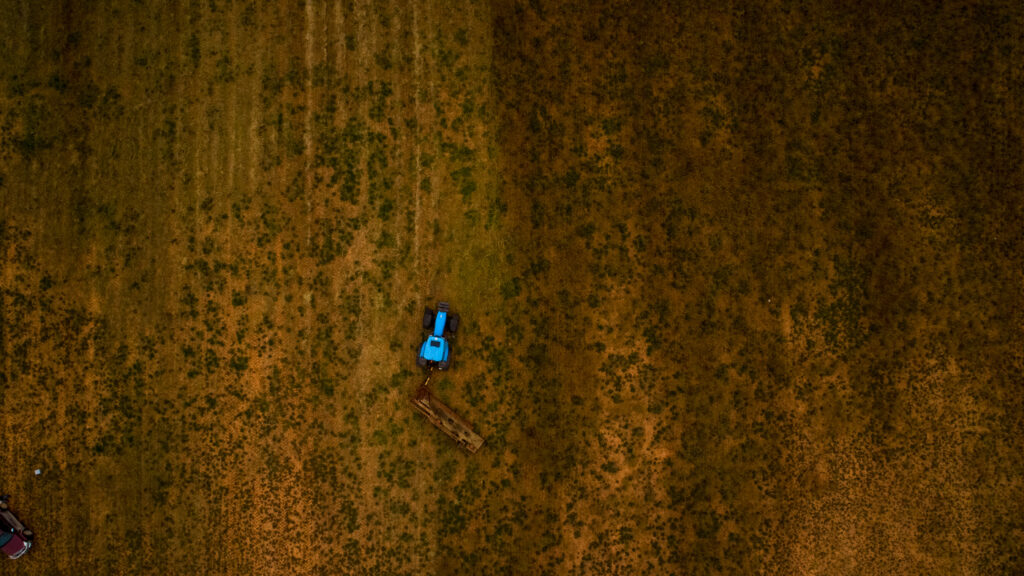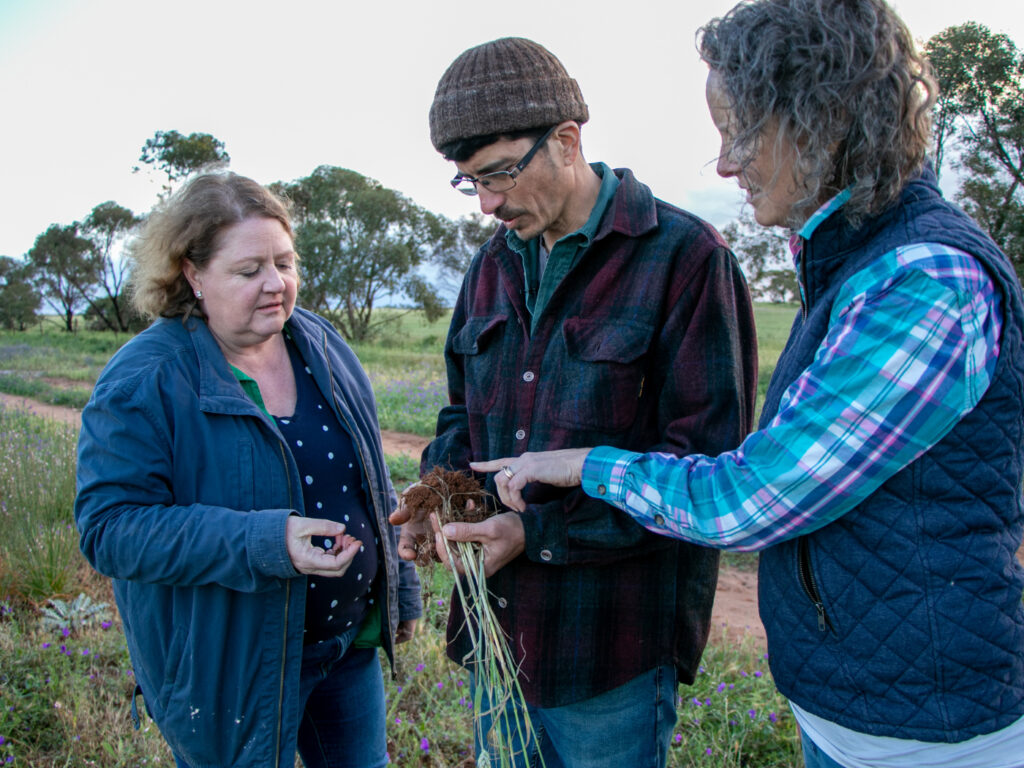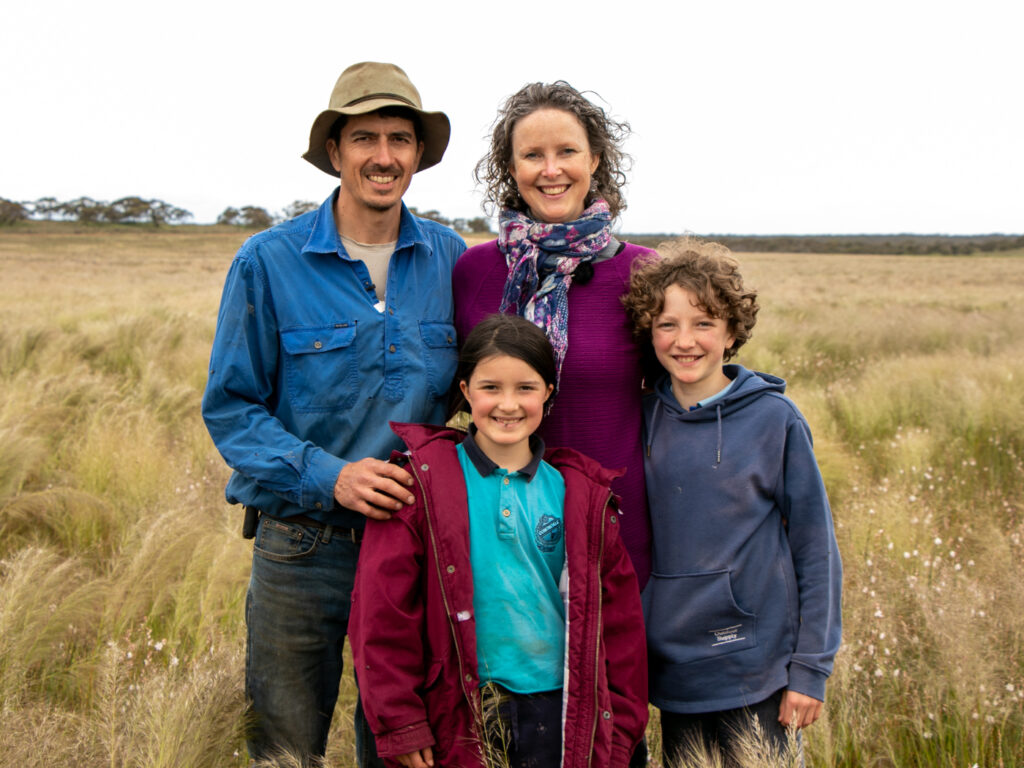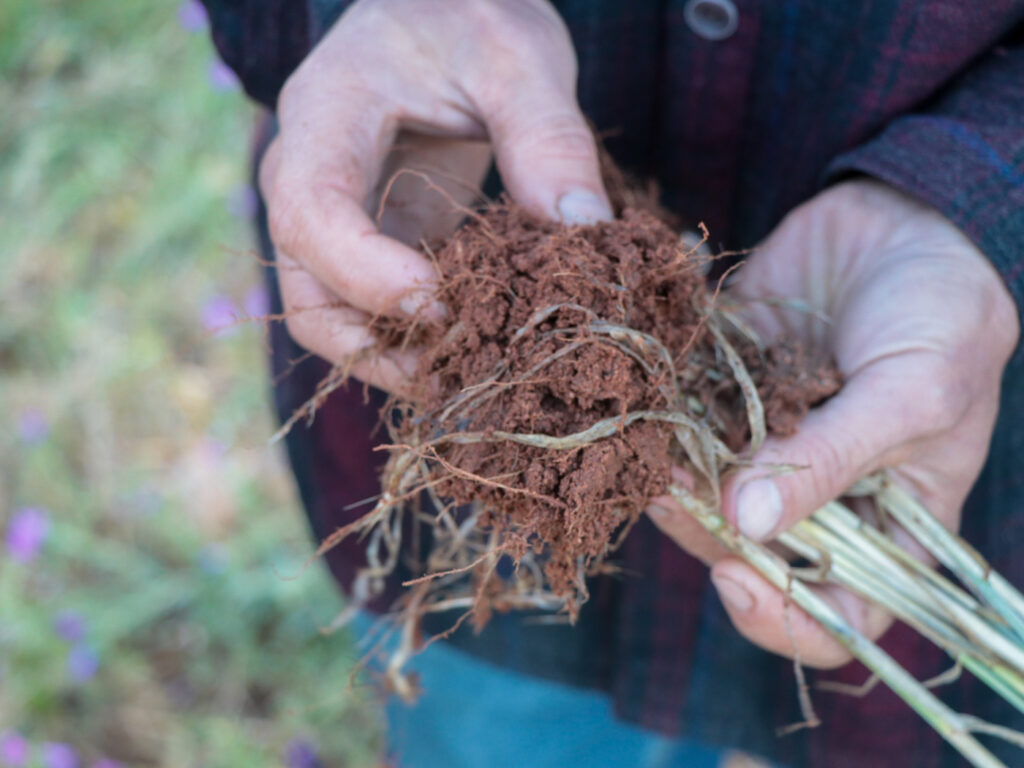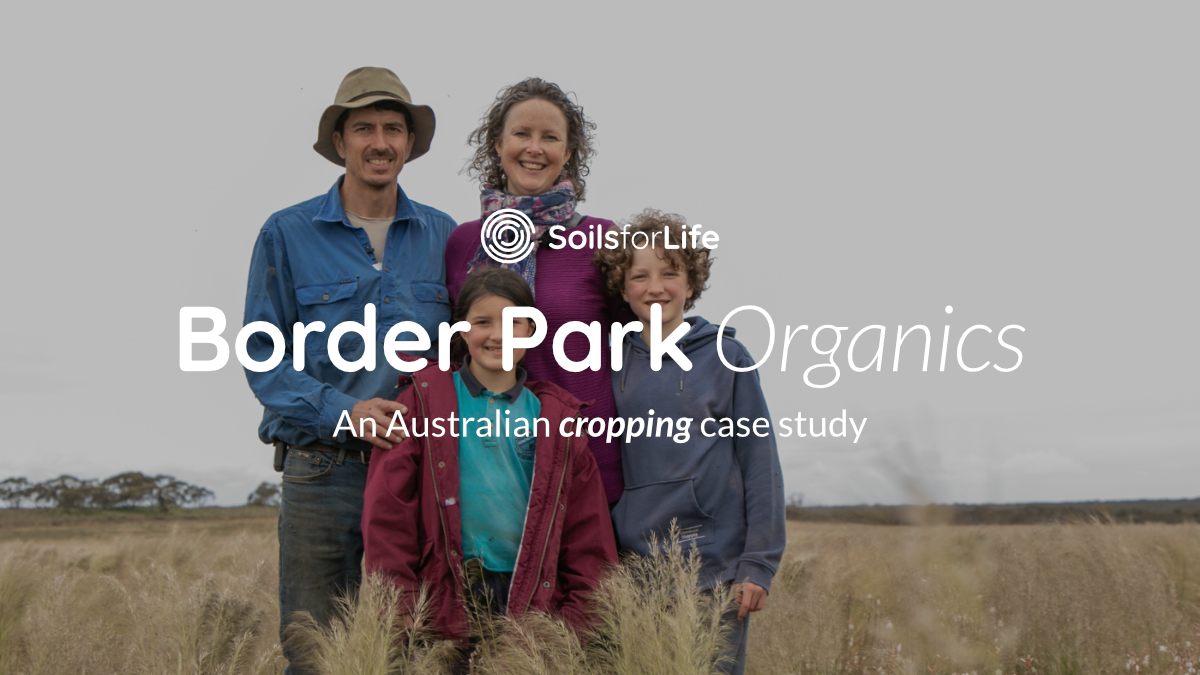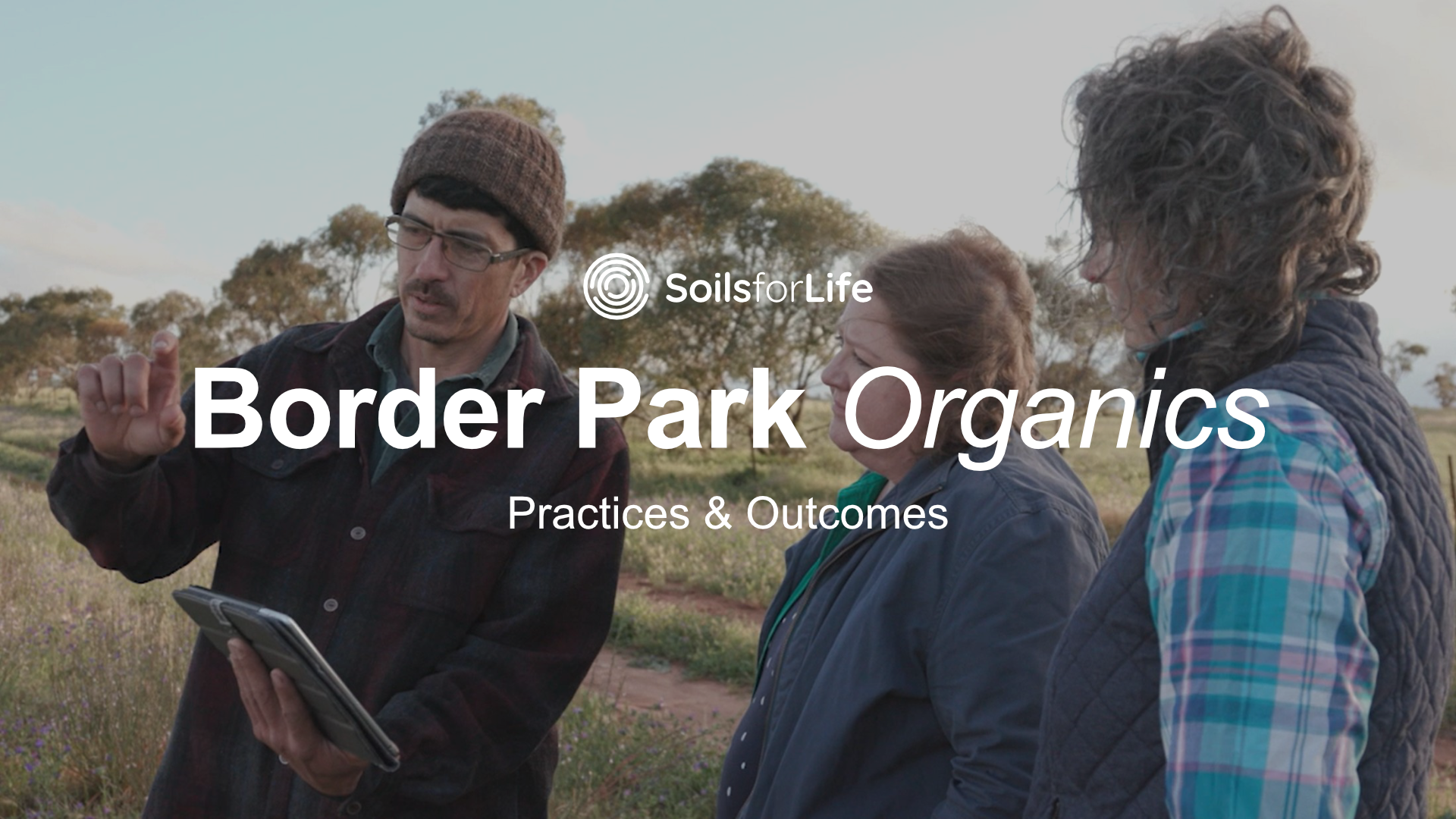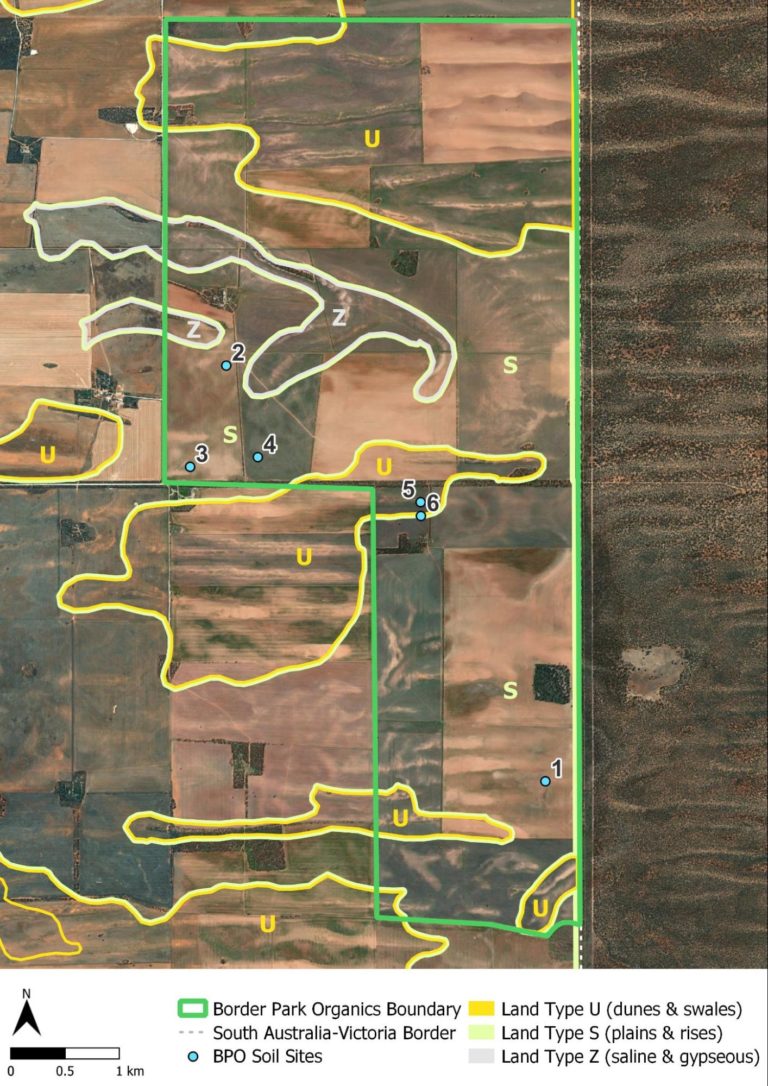The McIntoshs at Border Park Organics
An Australian CROPPING CASE STUDY | Published November 10, 2022
Meet Josh and Peri McIntosh who manage Border Park Organics. While Josh and Peri value the legacy they inherited and see great benefits in organic farming, the choices they have made since taking over the farm reflect a shift in thinking toward a systems health and systems management approach. The changes and their observations of impact have contributed to a sense of renewed hope for the future.
They took over the farm in 2014 after a three-year mentorship with John and Jenny Schwarz, which began in 2011. The Schwarzs began converting to organic farming in the 1990s, and Border Park Organics was fully certified in 1998. Border Park Organics is located in a dry landscape and the dominant soil types are light textured (sands to sandy loams), and well drained, so the efficient use of available water is critical. The McIntoshs learned early on that improving soil health would improve water availability for their crops. The 2018-20 drought was a real challenge for the family, and reinforced their commitment to managing the land and water cycles to prevent soil erosion and enhance nutrient retention.
Josh and Peri have learned that good nutrition is about more than excluding harmful inputs, and they now see a clear connection between healthy food, landscapes and soil. Now with their understanding of a nourishing diet, their approach to cropping has expanded beyond wheat to include a diverse mix of cereals and pulses. They are confident that diversifying what they grow can meet changing consumer appetites.
Today they adjust their ratio between cropping and animals to suit conditions.
For the long term, they recognise there are more opportunities with cropping on their farm, especially when matched with the improvements to soil health they have been making and the long-term potential outcomes from practice change.
The McIntoshs’ approach to farming now involves ‘encouraging growth, no matter what that looks like.’ Instead of always chasing weeds, they now recognise the role of all plants in regenerating soil health, and do this by supporting plant growth. Their three-year rotation includes a cover crop in the second year, in which minerals are added to be assimilated into the soil in time for the following cash crop season. Slashing and grazing of the cover are used to cycle nutrients back to the soil.
Farming at Border Park Organics has thrown many challenges their way, but Josh and Peri are resourceful people, guided by shared values, a strong sense of community and a can-do approach to life. While Josh and Peri value the legacy they inherited and see great benefits in organic farming, the choices they have made since taking over the farm reflect a shift in thinking toward a systems health and systems management approach. The changes and their observations of impact have contributed to a sense of renewed hope for the future.
Farm Facts
Location
Ngintait (northwest) and Ngarkat Country (south and west) | Taplan, SA
Climate
Hot dry summer, cold winter
Average Annual Rainfall
269 mm (1993-2022)
Agro-ecological Region
Mediterranean
Property Size
2390 ha
Elevation
28 – 58 m
Social Structure
Family owned and operated
Enterprise Type
Organic cropping of dryland grains and pulses (wheat, rye, barley, oats, triticale, peas, hay). Organic self-replacing Poll Hereford beef cattle and self-replacing Merino sheep for wool and fat lambs.
Growing Region
Southern Region (North SA Mallee sub-region)
Landscape
Plains, rises, and dunes with sparse pockets of remnant mallee vegetation
Soils*
Various soils including sands and sandy loams containing various forms of calcium carbonate (Calcarosols), gradational loamy sands or sandy loams containing calcium carbonate, but not throughout the profile (Kandosols1), and deep calcareous sands (Arenosols1 previously classified as Tenosols1).
1 The Australian Soil Classification (Isbell & NCST, 2021).
The Highlights
Practices and Innovations
Helpful Strategies
Indicators of Progress
- Keeping an active fallow to maximise year-round ground cover
- Shallow tillage
- Building organic matter in soils even in periods of drought
- Experimenting with staggered pasture cropping to maximise rolling benefits
- Experimenting with alternative weed management
- Using a disc chain instead of disc plough
- Slashing and grazing before reproductive stage to manage plant growth phases and feed soil
- Shelter belts for animal health, biodiversity, beneficial predators, wind-breaks
- Making cropping decisions based on nutrition and health (for humans and animals)
- Diversifying rotations to include mixed cover crop seed production
- Mindset of investing in the soil, with whole systems and landscape level thinking
- Reduce inputs and overall complexity through trials and experimentation
- Build soil health (which is not expensive but does require effort)
- Manage weeds before putting crops in rather than chasing them
- Create the conditions for ongoing experimentation and gain confidence as you go
- Respect inherited farming legacies while making changes
- Recognise that farming practices influence the water cycle
- Don’t invest a lot of money without understanding inter-related issues
- Caution and careful restraint can pay dividends
- A supportive consultancy process builds confidence and a vision for operations
- Fostering shared values, going slowly and enjoying life on the farm is important
- Improvements in soil health supports water efficiency for crops, with economic benefits
- Shallow disturbance of soil has improved soil and landscape health
- Cover crops and slashing leads to finer rooted annuals and denser ground cover
- Cover crops have supported better root systems in sandy soils
- Applications of compost has supported healthier crops
- A whole-of-system weed-management strategy has supported better soil health
- Shelter belts have had agricultural and landscape benefits, supporting animal health, biodiversity, beneficial predators and wind-breaks
- The McIntoshs’ approach allows for a slower pace and enjoying life together as a family on the farm.
Cropping landscape and soils
About the landscape
The landscape surrounding Border Park Organics includes plains and undulating rises and ridges overlying calcrete or calcrete rubble, wind-blown sand dunes and swales, and low-lying areas of saline land and gypsum deposits. Underlying clays have also been exposed lower in the landscape. Key soil and landscape factors in the region are low rainfall, low soil fertility, low soil water retention, and subsoil limitations including salinity and sodicity.
The entire property lies within the Loxton Land System (DEWNR Soil and Land Program), which is described as including calcareous soils (containing calcium carbonate) on the plains, rises and ridges; gradational sandy loams interspersed by the exposed clays also on the plains; and deep siliceous (silica dominant) sands on the dunes and swales.
Broadly speaking, cropping in south-east Australia depends on seasonal rainfall rather than soil water storage. Due to the low rainfall and lack of water sources, the McIntosh’s crops are rainfed and they purchase water (sourced from the River Murray) and pipe it across the property to supply their stock.
Vegetation associations include pockets of remnant eucalyptus mallee forest on the calcrete areas and mallee shrubland and spinifex on the sandy areas. Mallee pine may also occur in the unburnt areas on the deeper sands. In relation to ground cover, a range of grasses and forbs grow on the calcrete areas, daisies and common native grasses occur on the shallow sands, and annual herbs occur on the deeper sands (Willoughby, 2010).
Bird surveys of the Loxton landscape suggest that the Triodia (spinifex) landscape response group (LRG), including the Black-eared Miner and Mallee Emu-wren among others, has ceased to exist, and that the Generalist LRG (for example, the Variegated Fairy-wren and Crested Bellbird) has drastically declined. The Agricultural Increaser LRG (birds associated with the vegetation surrounding farmland), including the Australian Magpie, Crested Pigeon, and Galah, is common everywhere in the native vegetation of the landscape (Willoughby, 2010).
About the soils
Still within the Loxton Land System, Figure 1 shows the three Land Types reflecting the broad soil groups of the Border Park landscape (Figure 1) (DEWNR Soil and Land Program). The calcareous sandy loams of the plains and rises (Land Type S) are classified as Calcarosols; the loamy sands of the dunes and swales (Land Type U) are classified as Kandosols; and the deep calcareous sands (Land Type Z) are classified as Arenosols (previously classified as Tenosols1The Australian Soil Classification (Isbell & NCST, 2021).) (DEWNR Soil and Land Program; Isbell and NCST, 2021).

Figure 1. The broad soil groups (Land Types) at Border Park showing the loamy calcareous soils of the plains and rises (Land Type S); the siliceous sands of the dunes and swales (Land Type U); and the low-lying areas of saline soils associated with gypsum deposits (Land Type Z) (DEWNR Soil and Land Program). Note: These Land Types represent a regional overview and are not derived from detailed soil information. Source: Soils for Life.
Based on soil tests conducted between 2018 and 2021, the soils at Border Park are strongly alkaline, non-saline, and non-sodic (Landscape Board, 2022). The surface soils are typically sandy, resulting in high infiltration rates, with very low cation exchange capacity (CEC), and a low capacity to retain nutrients and water. The soils with heavier (clayey) subsoils have a higher CEC and a greater capacity to retain nutrients and water.
Josh and Peri understand that water is a major limiting factor to production in the region. Consequently, they have progressively implemented land management changes, including minimising soil disturbance and maintaining ground cover for longer periods of time, to improve their soil’s capacity to retain water.
The Border Park Organics story
- Phase 1 - Taking over the farm
- Phase 2 - An integrated system
- Phase 3 - Innovating through challenges
- Phase 4 - Where to now?
Taking over Border Park Organics
2011-2014
Buying their own family farm
Josh and Peri McIntosh married when they were young. They both come from farming families and the couple shared a wish that their seven children would grow up close to the land. When both of their parents sold their farms during the Millennium Drought (2001-2009), it was a devastating loss. After many years of hard work in separate industries, Josh and Peri yearned for a different lifestyle. The opportunity to take over an organic farming property – Border Park Organics – was presented through a family contact. Taking a leap of faith, the McIntoshs moved away from their friends and family to pursue a dream of working together and living a healthier life on a farm, according to their shared values. In 2011, the family moved to South Australia from regional New South Wales.
History of the property
Situated in the Northern Mallee, Border Park Organics is located in a semi-arid region prone to drought and very high summer temperatures. In close proximity to the Murray River, the farm has access to river water, which historically supported market gardens and the export of fresh food by train to the burgeoning city of Adelaide. The legacy of share-farming and the wide layering of enterprises are part of the history of the property.
Border Park Organics has operated as an organic farm for over three decades. Certification was established by John and Jenny Schwarz who began organic trials in 1990. The last herbicide was used in 1994 and the first part of the farm completed conversion and was certified in 1996, with the whole farm area certified in 1998. Border Park Organics adheres to the guidelines set out by organic and biodynamic standards and the National Association for Sustainable Agriculture Australia (NASAA).
Mentorship and non-family succession
Josh and Peri learnt about organic farming through a three-year mentorship with John and Jenny Schwarz, which began in 2011. The agreement ensured ongoing organic certification through NASAA. At the time of non-family succession in 2014, the majority of farming income came from cropping (90%), supplemented with sheep and cattle (10%). The cropping was largely based on three-year cropping rotations, strategically set up across the three main blocks of the farm, including different soil types, elevations and paddock sizes. Rye and four different varieties of wheat were grown, with the wheats on the heavier, better soils and rye on the ridges in the lighter soil. Josh describes the strategy as ‘providing a range’ to what was covered each season so that ‘no matter what way the season rolled out, there was production somewhere’.
The McIntoshs respected the hard work and legacy of John and Jenny Schwarz, and they wanted to continue farming organically. When they took over the property, they decided to farm without commercial debt, as the previous owners had done. Josh and Peri had carried substantial debt in their previous careers, and they both understood the stress and pressure that can come with it. Josh reflects:
Coming here and just accepting a different mindset … we’re going to sell lambs for a couple of years, sell wool and then we can buy that … and being an unreliable climate too – production wise – we’ve seen a lot of people struggle with overdraft and so often that then plays out in the stress of the marriage.
Managing the farm in the first year
Josh began thinking about potential changes to the farming system during his mentorship with John Schwarz. The first clue came from a pasture-cropping trial (based on Colin Seis’ practice), that began in 2009 and Josh contributed to over 2011 and 2012. John Schwarz bought a disc seeder and seeded winter cereal crop straight into a few paddocks that had good summer native grasses. This practice change suggested to Josh that you can potentially ‘make a go of farming without long term fallow’.
A major motivation for Josh and Peri to explore different farming practices came from a growing concern about the long-term viability of the farm based upon the soil profile. When they first became concerned about soil health, they didn’t have a name for it, but Josh would sometimes say that ‘organics is not enough’. They observed problems like soil erosion, but recognise now that neither of them understood the larger set of systemic issues at play. Josh had a ‘product mindset’ informed by his background in engineering and his previous experiences in farming, saying:
We see dust and soil blow away and we think, how can we keep doing this? You don’t get that back. And yet I knew very little about the soil. I’d done Ag College, but it was a different understanding, I guess. Still very products based. What can I buy to fix that problem? Rather than looking at the big system. And still in the mindset that, well, I can’t do much because I don’t have enough money.
During the handover, Josh and Peri questioned what they needed to do to ensure the future of the farm. The pre-existing business was profitable but it gradually became clearer that aspects of their farm ‘management needed to change’. Josh’s fundamental concerns about soil health and long-term viability led him to undertake desktop research to explore solutions:
I just started Googling soil health and trying to understand the problem. I come from an engineering background where we are given problems to solve, and the most important step is understanding what the issues are so we can then look at how to address them.
Josh began to recognise the complexity of soil biology and to see that ‘the more I understood about the soil, the less I understood about soil’. At the same time, Josh was introduced to the work of Dr EIaine Ingham by a friend. He was given a stack of Ingham’s CDs with hours of recorded lectures, and he followed this up with Professor Don Huber and John Kempf’s work. The insights the McIntoshs’ gained through reading, studying and learning about holistic approaches to soil and landscape systems in the early years contributed to a deeper understanding of the soil profile at Border Park Organics, and it helped to build their resilience on the property when facing periods of hardship. It also gave them confidence to begin experimenting with the practice changes they would undertake over the following years.
Approaching the farm as an integrated system
2015 – 2017
The McIntoshs identified early on that improving soil health would come with the benefit of water efficiency for their crops, which was an economic driver given the low annual rainfall and semi-arid farming profile. Over this period, this observation led them to explore methods for turning rain into biomass and innovative ways of keeping moisture in the soil. Early experiments, such as pasture cropping, created the conditions for ongoing experimentation. Their confidence increased seeing signs of the systemic benefit for the farm and longer-term farming cycles.
Pasture cropping trials
During his mentorship, Josh had participated in pasture cropping trials with John Schwarz. They were covering big areas, and in their region of South Australia, the approach worked well in good years. In an average year they could break-even, but quite often they didn’t get their seed back with pasture cropping and it was a time-consuming process. At the time, John and Josh agreed that they were not seeing the kind of consistent results they needed to see from a cropping enterprise.
While pasture cropping wasn’t an entirely successful experiment in terms of grain, it benefitted the livestock and Josh saw potential based on other positive impacts within the larger farming system. For example, they were saving money on diesel because they didn’t work the ground as much. And because they were not leaving soil bare, there were benefits both for the soil and their livestock over time, as Josh notes, ‘pasture cropping spreads enterprises out in effective ways’. Josh began to see a bigger picture that was not focused entirely on the quantity of grain per annum but a longer-term set of benefits that could be both profitable and healthier in essential ways. The benefits they observed after further pasture cropping trials from 2015 onwards were increased native summer grass cover and resulting pasture availability, and reduced wind erosion.
Returning challenging paddocks to native grasses
During the first phase of practice change, Josh and Peri began to question the legitimacy of cropping certain areas within paddocks that had been previously farmed, such as on gypsum ridges and shallow rock. Instead, they saw new value in facilitating the growth of perennial native grasses. From 2015 onwards, they began to leave these areas to native pasture and to utilise them within the livestock cycle, rather than ‘wasting seed’ to plant them out, and expensive diesel to harvest crops not well suited to the conditions. This had multiple benefits, including reducing erosion and saving money on diesel, which is one of their greatest expenses.
Weed management and inter-row cultivation
Josh and Peri inherited an approach to weed management within the cropping routine that involved an opening pass with a one-way disc plough and a long bare fallow in preparation for the next year’s winter crop. The process began in September following a rain event, and would continue in order to keep the weed burden under control until the planting window in late April-May. The aim was to plant quickly to out-compete the weeds. However, multiple passings compromised soil moisture levels and they often didn’t get the clean crop they hoped for. Peri recalls, ‘it just felt like we were fighting this losing battle.’
They began to explore alternative approaches to weed control. One of the first things tried was inter-row cultivation. Josh trialled inter-row cultivation because, ‘everything we had been doing for weed control before was pre-seeding,’ and he wanted to find a way to control weeds during the growing season.
Inter-row cultivation required a change from sweeps to points for seeding, so that at a certain stage in plant growth Josh could go through with an inter-row cultivator which they had leased for a couple of years. While these early experiments gave the McIntoshs ‘another tool’ for dealing with weeds, over time, Josh came to think:
Inter-row cultivation is definitely a tool that’d be handy to have, but as something that you rely on as a foundation, it doesn’t work. It’s like the icing on a cake, it’s not what the cake’s made of. And so, it’s back again to the whole system.
As Josh continued to look for alternative approaches to weed management, he was influenced by an organic farmer in the UK, John Pawsey. Pawsey suggested to Josh that ‘you don’t want to be chasing weeds in-crop, you want to be managing to control weeds before you put your crop in.’ Pawsey had shifted his own practice from inter-row cultivation, into long ley pasture, ley fallows, and then intensive cultivation. Pawsey’s advice made sense to Josh and he could see how the approach could work for them in the long term. From 2017 onwards, they began to control weeds like rye grass the year before the crop, not in crop, through multispecies cropping, slashing and grazing.
Mixed cover crops for seed production, ground cover and soil health
In 2017, the McIntoshs began trialling mixed cover crops for the seed market, seeing potential in terms of diversifying to include mixes suitable for dairy feed ration and mixed cover crop seed. Based on their observations of increasing customer demand, their plan was to supply to the growing market. During this period, they explored possibilities for separating and preparing ratios that particular customers need. For example, in their “H2” paddock they sowed peas and oats together, and harvested this in 2017 with great success as cover crop seed mixes.
Shifting from a disc plough to a disc chain
In 2017, Josh decided to move away from using a disc plough and began to work instead with a disc chain. Using a disc chain allowed them to ‘prepare ground quicker, which meant we didn’t have to start so early.’ At Border Park, the ‘timing of tillage operations is critical’ and shifting to a disc chain allowed Josh to prepare soil at a rate three times quicker than their previous range of machines, as it could be done in one pass instead of three passes over several weeks, when conditions were optimal. While the depth of tillage was shallow, the aggressiveness of the tillage action could be controlled to suit the conditions better. Using a disc chain conserved moisture after tillage better than any other machine they had, and it induced a vibrant germination of seeds in the surface without burying the seed below germination depth.
One of Josh’s favourite observations of the immediate changes to soil after the disc chain was seeing the activity when the bulk plant residues were mixed back into the shallow surface layer of soil. Because they are only working two inches deep, Josh noticed:
Right where the activity is, it’s warm, it’s moist and the microbes just go crazy in that. And even though it’s working intensely, it’s mixing all that stuff together and it’s like a paper mâché type consistency rather than it being fine and dusty and blowing away. It’s kind of counterintuitive to me that we’re working more intensely but we’re getting more wind resilience with that method. And a greater sort of protection I guess from the heat too like summer. The soil temperatures are really high if you’ve got bare fallow.
The disc chain could better incorporate mature plant matter into the soil to prevent it oxidising, and the disc chain finish was like a garden mulch instead of a bare fallow because the surface matter is not mixed deep but concentrated in the top 40 to 60 mm. The McIntoshs were also observing longer term benefits from the disc chain. Firstly, the disc chain enabled better overall weed control. When using it on grazing land, Josh noticed that it ‘reset’ the species mix from ‘woody perennial dominance to a strong stand of palatable species like medic and ryegrass,’ which were not seeded, but grew from naturalised seed. An added benefit was the proliferation of native grasses in the following spring that began to grow from seedlings and from deeper undisturbed native grass crowns that survived the shallow tillage.
Innovating through challenges
2018 – 2021
Between 2018 and 2021, Josh and Peri faced many unforeseen challenges, including severe drought (2018-2020), hail, reduced cash flow, and the COVID-19 pandemic, which brought significant change to markets. These major barriers and setbacks tested the McIntoshs’ resolve. Josh and Peri experimented with diverse practice changes over this period, which offered rich learning opportunities and supported innovation.
Experimenting with inputs: biologicals, biostimulants and foliars
The McIntoshs experimented with a range of products and home-made inputs, including composts, liquids and seed coatings. They started with liquids and formulating foliar sprays, informed by Elaine Ingham and John Kempf, to understand how plant roots were interacting with the soil through biology. Based on what he was learning, Josh trialled worm juice followed by worm castings. They used pelletised worm castings in 2018 to put a rye crop in along with the seed, but there was so little rain that season, Josh recalls:
The whole season the pelletised worm castings stayed as a pellet form up near the surface, and there wasn’t enough moisture for the plant to access that fertiliser.
Josh has since observed that with rainfall, pelletised worm castings are ‘good stuff’, as long as it cycles through and is accessible to the germinating plant. While experimenting with worm-based products, they also began brewing their own biostimulant liquid inoculants. The liquid was a broad-spectrum soil microbe, including plant symbionts and inoculates mixed in an aerated, temperature-controlled brewing tank. At this time, Josh was thinking of broad-spectrum liquids as a way to introduce food for soil biology (rather than chemistry for plant nutrition), and they used this liquid both as a seed-coating and in-furrow liquid injection.
Slashing and grazing to manage plant growth phases and feed soil
In 2018, the McIntoshs wanted to improve the balance between their cover blends and cash crops. Their best biomass-producing cover blends were predominantly either triticale and peas, or rye and vetch. All of these species need to be terminated properly to avoid subsequent cash crop contamination. The McIntoshs couldn’t carry enough livestock to effectively terminate the cover crop with grazing because they ran their animals without supplemental feeding, preferring grain-free pasture, and they were cautious in managing numbers to avoid damage to the land. They needed to find a way to ensure all the cover crops were properly terminated, so they slashed a mixed-species cover crop and grazed the regrowth after the slashed bulk had mostly broken down into the soil. This method increased biomass production, provided ground cover, reduced problematic seed-set and also benefited the livestock. The McIntoshs found that slashing with optimal timing stopped seed set of the cover crop species, and that grazing could then be used effectively to tidy up late heads and regrowth.
Josh also slashed volunteer non-palatable perennials to promote more growth and used them as a soil builder. This would add a layer of mulch on the soil surface as a soil builder and feed soil microbes. He began to find that ‘even the slashed material can oxidise too much and not assimilate with soil as much as I’d like,’ so he began to also consider trying a ‘spray application’ of a microbial based solution combined with a ‘spiked disc chain pass to lightly incorporate the material to promote better microbial breakdown of the slashed material.’
Dry vs wet planting
An important consideration at this time involved the timing of plantings – before or after rain – and these decisions overlapped their efforts to find effective weed management alternatives. Josh recalls how, ‘we needed to build up what we were working into, and what we were expecting to grow into’, and to develop a ‘bigger sponge’ in their soil profile with greater capacity for water retention, which is something they have worked on since.
Avoiding costly investments in equipment
Over this period, Josh and Peri learnt how to utilise the equipment they had available on farm, they made changes to existing equipment, and they leased and bought equipment as one-off investments. Peri reflects:
We can’t just rely on one type of seeder or one type of spreader or whatever. We have seen that because the years are so variable and our soils are so variable and the different seeds that we’re doing, we need to have a very diverse range of equipment.
Equipment and facilities are generally a significant cost in cropping. Josh and Peri’s decisions often came down to prioritising what was manageable and financially viable given they were only spending what they had available as savings. Peri is grateful they didn’t get ‘locked into a certain set of practices’ because they didn’t invest heavily in products or equipment early on (a common challenge for farmers). In hindsight, Josh and Peri now know more precisely what they need to invest in, and they didn’t go into debt buying equipment they don’t use. This approach kept them agile and responsive to changing circumstances.
Financial benchmarking through a federal program
The McIntoshs were struggling with lower production and profit during the severe drought of 2018-20. They heard about a government funded opportunity to work with a business analyst, and decided to approach them. In 2020, they established a benchmark for farm finances and planning for a five-year trajectory. Gaining greater knowledge and clarity about their finances was affirmative and hopeful because they discovered that they were in a relatively strong position, despite the challenges they have faced. The outcome built their confidence in terms of where to invest their energy because it confirmed the importance of building soil health. According to Josh, the process ‘all pointed to soil health, which was really good’.
Where to now?
2022 – ongoing
The main enterprises at Border Park Organics continue to be cropping, sheep and cattle. Levels of production are variable, as Josh suggests ‘anything from 1000 tonnes of grain to nothing, depending how the season goes’, with 300-400 breeding ewes and 25-40 breeding cattle. The McIntoshs shift their ratio between cropping and animals to suit conditions, and for the long term they recognise there are more opportunities with cropping on their farm, especially when matched with the improvements to soil health that they have been making and the long-term potential of this. Wheat is still the highest yield and income from cereals; however, they are looking at market changes and different customer demands, and trying to diversify where possible.
Whole farm management decisions
Their current three-year rotation is the same allocation of paddocks as when they started farming, but now includes a cover crop in the second pasture year to produce biomass. Minerals added in the cover crop phase are assimilated into the soil for the following cash crop season. Slashing and grazing of the cover crops are then used to cycle nutrients back to the soil. Josh’s intention is to have seed mixes ready to seed whenever they have moisture for summer or winter plants to establish, even if they don’t mature. The McIntoshs continue to use slashing because they can’t carry enough livestock to terminate cover crops. If they traded livestock, Josh thinks they could potentially apply enough grazing pressure and:
Trading would closer mimic the transitory nature of grazing wildlife in this climate rather than trying to carry breeders through the feed gaps in mid-winter and late summer. However, trading is challenging under organic management.
Therefore, the change to trading instead of closed breeding of sheep and cattle is something that may happen in future, but Josh also says, it ‘hurts to think of saying goodbye to my ewes and cows.’
Josh has begun a two-year rotation trial in one paddock of:
- Year 1 warm-season spring: cover crop seeded with minerals and liquid during ripping
- Year 1 spring: slash to provide protective soil cover during summer
- Year 1 cool-season: cover disc seeded into the residue of the previous summer cover
- Year 2 winter: cash crop under-seeded with a warm season spring cover that can establish after harvest if there is rain.
The McIntoshs hope to apply a two-year rotation across the whole-farm in the future and will closely observe the trial to see how to viably capture every potential growing opportunity. Josh says, ‘these covers don’t need to do more than establish, receive the foliars and maintain habitat for microbes’ and he is counting on suppression by cover crops to reduce ryegrass seed set.
Seed dressings and bio-stimulants
The McIntoshs have mostly transitioned away from using off-the-shelf seed dressings towards working to understand ‘better what a particular seed needs, what chemicals, stimulants or minerals that plant needs to connect with the soil’. Bio-stimulants in the seed dressing have been really important to stimulate and facilitate the connection between the seed and the soil because ‘that’s where it’s all got to start’. As Josh sees it, having a basic understanding of a plant’s needs is the first necessary step to having an influence on growth and productivity through nutrients, minerals and bio-stimulants:
In terms of regeneration, the things that give us the best outcomes in terms of soil health are actually not expensive at all. Like cover crop seeds that we can source off farm and biology that we can multiply in our brewing tank. And then mineral seed dressing, they’re a few dollars a hectare […] It really is very economical.
When treating seeds, they use a bio-stimulant ratio made locally by a producer who supplies 1000 litre batches. They use an auger, with a 1000 litre shuttle, 12-volt vane pump, a garden hose with garden socket on top of the auger, about a meter up from the bottom. They stick the hose on and run the pump and auger to produce about 15 litres a ton of seed, which they run out of the silo. This ratio works and is based on their measurement and calibration to 15 litres per ton. This approach to seed dressing has been very successful, and when they do small seed sales to organic orchards and vineyards, people are often grateful if the seed has already been coated because it gives them a better kickstart.
Detailed records for decision-making
Josh and Peri’s general approach to cropping now involves balancing flexibility with a lot of mindful preparation, building on their past experiences and observations to inform their current and future decision making. Logistically they need enough of a pattern to be able to plan, prepare and know where they’re heading, while also running a set of rotations that can be changed at the last minute if needed:
It is like you have started with an open slate, and then something happens, so you get an early rain, and that shifts all the late rain options off the table, and you’re left with all the early rain options, and then the next thing might happen. You might get a big summer rain, and that shifts half of that options off the table, and so, as the season goes on, it narrows down to an optimum outcome at the end which we go with.
Josh is a meticulous record keeper, and he attributes his ability to manage the farm successfully to his close observations of changes over time. Drawing from observations over the past 10 years, Josh has developed a rule of thumb he applies to the timing of planting. It helps him to recognise patterns and takes some of the guess work out of decisions.
Josh uses his rule of thumb to help guide the timing of weed control passes before seeding. By his estimation, the minimum amount of rain that needs to fall on disc chained ground for the majority of ryegrass to germinate and for enough moisture to remain after 100 hrs is about 4mm. Once Josh has measured 4 mm of rain, he waits 100 hours (4 days and 4 hours) before cultivating. Cultivating sooner doesn’t kill all the weeds and cultivating later means the ground is too dry and will become susceptible to wind erosion. The rule needs to be adjusted slightly for temperature and wind conditions, and gives Josh ‘go’ / ‘no-go’ parameters, as he describes:
I’ve looked back over how paddocks have responded to my timing and to the amount of rain, and I’ve worked out you need a hundred hours to get a germination enough, that you will then reduce that germination by working it rather than induce it.
Farming for a nutritious diet
Even though wheat is their highest yield and income from cereals, Josh and Peri are exploring moving away from solidly milling wheat. This decision is based on their understanding of a nutritious diet (for both human and animal consumption). Peri explains, healthy diets need:
A range of things, and probably that’s been mirrored in the way we’ve shifted to what we grow now, with more legumes, rye, barley and oats. More of a blend of things than just focusing on milling wheat.
They are watching market changes and customer demand to help inform their decisions around diversifying to more dairy feed or mixed cover crop seed. There are many opportunities to explore and they are well connected and open to possible changes in operations and modes of distribution.
Encouraging growth, no matter what
A deeper understanding of soil health has led the McIntoshs to recognise that plant growth is key, as ‘growth produces growth’. The way the McIntoshs encourage plant growth now reflects their deeper understanding of the differences between effective management decisions and quick-fix inputs. This comes down to appropriate times for action and the flow-on effects of specific decisions in terms of plant growth and larger cycles. As Josh suggests, these are the ‘little ways that I can control or manage an outcome, on management rather than input, doing the same thing, just at different times’. Josh continues to refine his knowledge and appreciation of plants and plant succession. There are subtle practice changes that he is undertaking on the land based on his closer understanding of the plant-soil microbiome, and accumulated observations of plant succession, and an overall aim now to support soils regenerating themselves, through plant growth.
Adaptive management, mixed-enterprise and community building
Looking ahead, Josh and Peri would like to find ways to overcome the production challenges they face due to volatile climate and markets. Finding adaptive management approaches that enable the funding of soil health improvements will be key to their ongoing farming business. An enterprise-layered farm is their ideal, however they see this as an ‘aspiration point’ currently and something to slowly work towards. They have explored possibilities of stacking enterprises and bringing more people back onto the land to collaborate in new opportunities and to build up the local farming community.
Indicators of progress
Key insights
The McIntoshs continue to refine their model of an extensive organic farm, producing winter cereal and livestock in a challenging low rainfall environment and with a low capital base. Their approach has involved experimentation to find a different way of farming that meets their unique goals and context.
While the impact of their management changes will take time to be fully evident, it is clear their strategies are beginning to deliver improved soil and landscape health. As a result of these changes, they have observed:
- Improved soil health following shallow disturbance
- Better root systems, finer rooted annual grasses and denser ground cover following use of cover crops
- Rapid re-emergence of a diversity of soil-nurturing and soil-stabilising native grasses on another site that has been rested from cropping
- Improved water efficiency for crops due to better soil health
- Healthier crops following compost applications
- Reduced costs from reductions in fossil fuel use
- A significant increase in biodiversity – especially bird life – throughout the property as plant diversity has increased and tree plantings have become established.
The soil test results illustrate some of these changes, with the highest Haney soil health scores were in the long-term trial sites. These trials will help inform future rotations and other management decisions, with the goals of improving soil health across the farm, growing more nutritious produce, and increasing resilience of crop and pasture production.
Josh and Peri have entered into a lease-to-buy arrangement, which will allow them to acquire the property over time without taking on high levels of debt. This requires sufficient levels of profitability in order to service the purchasing arrangement. The business had an extremely challenging year in 2019-20, with planned one-off infrastructure costs combined with an unprecedented drought, hail damage to the crop, and COVID19 impacts on direct marketing sales. The business recorded a loss of $244,000 in this year. However, the next year costs reduced slightly and trading income increased sixfold, delivering an overall profit of $278,000. While data is limited to these two years, the trend is positive, and they also expect some of their practices and new markets to deliver additional value in coming years. This gives the family renewed hope for the future.
Approach to collecting indicators
Farms are complex social and agro-ecological systems, and each farmer has different goals, which means a different approach to monitoring is required for every farm. For Soils for Life case studies, we are guided by the case study farmer’s goals, and take a holistic view that includes an assessment of progress towards social/personal, ecological and financial outcomes. The information presented in this section is based on available data at the time of reporting and may be influenced by seasonal or market conditions. This report should be read with this context in mind.
Given the water limitations in their region, Josh and Peri have focused on building the water holding capacity of their soils. When nutrients and water are scarce, it is especially important to test and consider both the available and total nutrients to fully understand the requirements for the optimal function and interaction of the soil, microbe and plant systems. This approach to soil health reflects the capacity of the soil to function, rather than just the inherent properties of the soil.
Josh and Peri’s approach to land management is aiming to achieve:
- A healthy and biologically active soil with good levels of organic matter
- Greater water efficiency for cropping
- Diversified soil biota through increased plant diversity
- Improvements to soil health through modifications to rotations and species selection
- Farm operations that honour the organic heritage of the property
- Working collaboratively and harmoniously with previous owners
- A comfortable level of income for the family with minimal debt.
Soils for Life investigated progress towards the McIntosh’s goals through:
- Interviews and surveys with Josh and Peri
- Reviewing information and data compiled over the years by Josh and Peri
- Soil and landscape observations
- A series of chemical and biological tests of soil samples collected at seven sites across the farm.
Further details on these investigations are provided in the ‘Deeper insights’ sections below.
Deeper insights - Soil and landscape
Soil and landscape analysis method
Soil and landscape observations included:
- Above ground observations of vegetation and waterways
- Below ground observations of soil structure, colour, smell, plant roots, bacteria, and fungi.
In addition, soil samples were collected from 0-10 cm depth along a transect at five sites across the farm (see Figure 4 below). The samples were submitted for three complementary laboratory test suites, each of which provides a different perspective on the chemical and biological contents and condition of the soil. Each lab provides reference ranges against which the Young Seeds results can be compared:
- Agricultural Soil Analysis2Analysis undertaken by the Environmental Analysis Laboratory (EAL). Please refer to this EAL example of an Agricultural Soil Analysis Report for the EAL guidelines and ranges that SfL has used to guide interpretation in this report. – a suite of chemical tests to identify the available and total nutrient levels to support farm management.
- Haney Soil Health3Analysis undertaken by the Environmental Analysis Laboratory (EAL). Please refer to this EAL example of a Haney Soil Analysis Report for the guidelines and ranges that SfL has referred to in this report. – a suite of tests to indicate the size and functionality of the soil microbial community, including soil respiration, Water Extractable Organic Carbon (WEOC) as an energy source, and Water Extractable Organic Nitrogen (WEON) as a nutrition source.
- Soil Foodweb4 Analysis, guidelines and ranges provided by the Soil Foodweb Institute (SFI), which SfL has used to guide the interpretation in this report. – a snapshot in time of the types of microbial “workers” present in the soil.
Six sites were selected at Border Park Organics, namely:
Site 1 (not recently cropped) Cropped every 3 years since 1996, using ploughs and five to eight months of conservation tillage fallow and rotational grazing. Gone to volunteer pasture with return of native perennials in its 3rd and 4th year without being cropped.
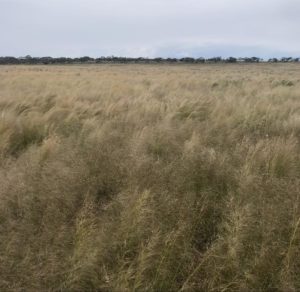
Site 2 (recent trials, north) Site 2 and 3 are the same paddock (north and south), with variations in management, crop selection, topography and soil type. 2018 multispecies cover crop (ploughed termination); 2019 wheat (not harvested); 2020-21 grazed volunteer pasture; 2022 wheat. 2022 – 2 tonnes of Partially Matured Compost (PMC) (the ridges on western side had 3 tonnes).
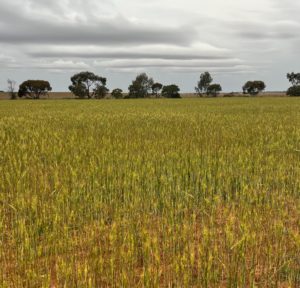
Site 3 (recent trials, south) Site 2 and 3 are the same paddock (north and south), with variations in management, crop selection, topography and soil type. 2018 multispecies cover crop (ploughed termination); 2019 rye (not harvested), 2020-21 grazed volunteer pasture; 2022 rye. 2022 – 2 tonnes of Partially Matured Compost (PMC) (ridges on western side had 3 tonnes).

Site 4 (intensive) History of biomass production with intensive utilisation of growing conditions. Worked fallow with wheat (2014 and 2017); knife points to direct drill cover crop (2019) during drought. 2019 cool season cover crop; 2020 wheat; 2021 regrowth wheat and peas; 2022 ploughed at sampling.
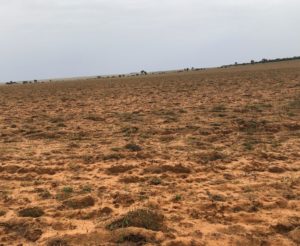
Site 5 (long-term trials, north-facing ridge) Site 5 and 6 are the same paddock (north and south) with different crop selection, topography and soil type. Maximising ground cover with mixed species cover and feeding soil via plants, grazing and slashing. Site 5 (north; on a ridge). 2019 Triticale; 2020 mixed cover crop, grazed; 2021 triticale cover (hailed out); 2022 rye (right side of image).
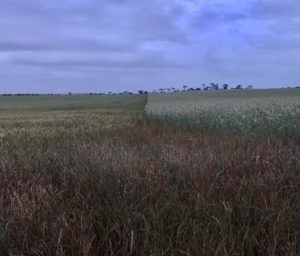
Site 6 (long-term trials, south facing flats) Site 5 and 6 are the same paddock (north and south) with different crop selection, topography and soil type. Maximising ground cover with mixed species cover and feeding soil via plants, grazing and slashing. Site 6 (south; on the flat). 2019 wheat; 2020 mixed cover crop, grazed; 2021 triticale cover (hailed out); 2022 wheat (left side of image).

Figure 3. The broad soil groups (Land Types) at Border Park Organics with an overlay of the soil sampling sites selected by the Soils for Life team and the McIntoshs in October 2022. Source: Soils for Life. Note: The Land Types represent a regional overview and are not derived from detailed soil information.
Interpretation of soil test results
Soil is one of the most complex ecosystems on the planet. The three laboratory test suites have been chosen to provide complementary perspectives on soil health, and contain a considerable amount of information on soil chemistry, biology and functionality. However, soil tests represent a fraction of the complexity of the soil system at a single point in time – in this case, the samples were collected in October, when the temperatures were rising and winter crops were yet to be harvested.
Importantly, the comparative averages, guidelines and ranges referred to in this report reflect those provided in the laboratory-generated reports and are not necessarily specific to the farming property, region, soil characteristics, history and management goals.
Snapshots of the results from these tests are shown in Figure 4 below, and the full results are provided in Appendices A, B and C. Note: Each row of results has been coloured using a grey scale, where the lightest colour is the lowest number and the darkest colour is the highest number in the row. Colour coding does NOT indicate positive or negative results, and is merely provided to allow simple visual comparison of the numbers in each row. The results need to be interpreted with care (repeated testing over time is necessary to produce reliable insights and trends).
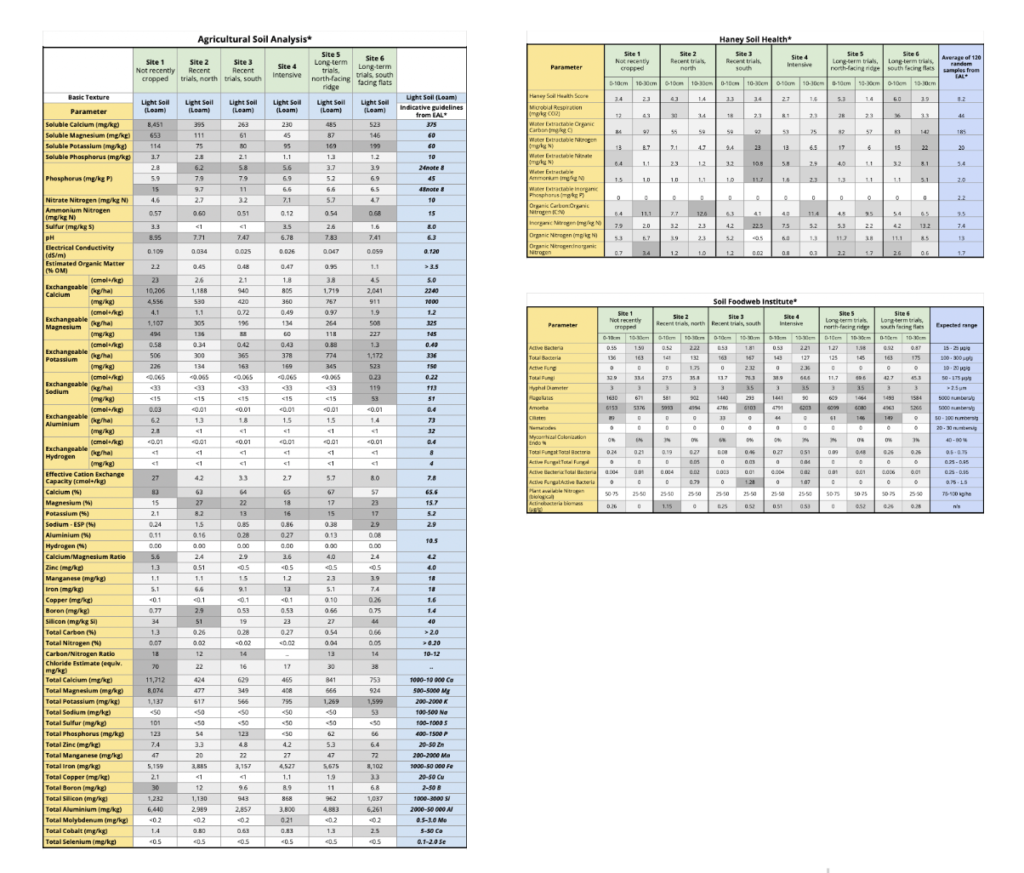
Figure 4. Snapshots of results from Border Park Organics soil tests. Source: EAL; Soil Foodweb Institute; Soils for Life. See Appendices A, B and C for full detail.
- The highest Haney soil health scores were evident in the samples collected from sites 5 and 6. Both sites have had extensive long-term trials and reflect the potential of practice-change to increase soil health.
- Site 1 demonstrates that within a short period of time (3 to 4 years), with rest from cropping, a diversity of native grass seeds in the soil germinated and flourished. The soil results from this site also show improved soil functionality, including the highest levels of organic matter of all the sites sampled. These results could be used to inform future modified cropping rotations.
- Across all sites, the size and activity levels of the biological communities either increased or were maintained at depths between 10-30 cm, compared to 0-10 cm. This, in part, can be attributed to the hot and dry site conditions, but is also likely a result of Josh’s intentional implementation of practices to maintain the conditions for biological communities at depth.
- The soil chemistry results show that the available and total phosphorus, sulphur, carbon, nitrogen, and micronutrients are lower than EAL’s indicative ranges for loam soils.
- The soil at site 1 is strongly alkaline (8.95 at 0-10 cm), with comparatively high cation exchange capacity (CEC) driven by the high (excess) available calcium presented as a percent of the base saturation (Ca %) and the total calcium levels. These high calcium levels can create light, blow-away, easily pulverised soils that are prone to soil moisture loss. Josh is trying to manage this through adjusting rotations to maximise the amount of time this soil is covered with living plants.
- Most sites had calcium base saturation percentages within the optimal range, which is essential for soil aeration and water flow. However, magnesium and potassium base saturation are high at most sites, which can compromise the functionality that good calcium levels provide.
- All sites had higher than ideal base saturation of magnesium, and all sites except site 1 had potassium above the ideal range.
A high base saturation of magnesium can: reduce calcium and phosphorus and potassium uptake in plants and animals; reduce soil porosity and increase soil strength; and induce poor uptake of magnesium by plants (commonly referred to as ‘hidden hunger’).
A high base saturation of potassium can: affect calcium and magnesium functionality; lead to increasing soil strength; and lead to increased weed pressures, especially if potassium (K) is greater than 7.5% of the base saturation.
Other landscape observations
When Josh and Peri inherited the farm, there were existing mature shelter belts and tree lines that had been planted by John and Jenny Schwarz. As soon as the trees gained some height, they were observed to support bird life and provided corridors of habitat for birds flying in from the nearby National Parks. John and Jenny observed a substantial increase in bird numbers compared to when they purchased the land (prior to planting).
Josh and Peri appreciate the diversity of species that live on the property (micro-organisms, plants and animals included). They note the symbiotic connections between their healthy landscape and agricultural benefits for Border Park Organics, which include beneficial predators, animal health, biodiversity and wind-breaks.
Deeper Insights - Farmer and farm
Personal and family outcomes
To explore farmers’ perception of change in their personal relationships over time, Soils for Life created a wellbeing survey of six themes with associated indicators (Table 2)5 This wellbeing survey combines questions from four sources: the Regional Wellbeing Survey (University of Canberra); Vanguard Business Services ‘People Perspective’ survey; Regenerative pillars (For the Love of Soil, Nicole Masters); and the personal Wellbeing Index 11 (Australian Centre on Quality of Life, 2020). The Wellbeing Index 11 indicators – used by researchers (Schirmer, Yabsley, Mylek, & Peel, 2016) and in the long-term broadscale Regional Wellbeing Survey conducted by the University of Canberra (2020) – are considered important for holistically measuring the sustainability of farming systems (Brown et al., 2021). . Farmers ranked each of these indicators, across all four phases, on a seven point scale from: very unhappy (1); unhappy (2); mostly dissatisfied (3); mixed (4); mostly satisfied (5); pleased (6); to very pleased (7). We then averaged the indicators to graph the ‘theme averages’ and observe their relative change over time, across the four phases (Figure 5). We also indicate below where any specific indicators are outliers in comparison to the general trend of other indicators in its theme.
Table 2. The six themes and indicators of personal relationships in the wellbeing survey.
| Relationships with: | Indicators |
| Self |
|
| Family |
|
| Friends and community |
|
| Farming |
|
| Land |
|
| Life |
|
Josh McIntosh’s survey results reflect a complex story of hardship, as well as hope, faith and resilience (see Figure 5). The rewards of their decision to pursue a dream of living on an organic farm is mirrored in Josh’s upward trajectory across five themes between Phase 1 and Phase 2: family, farming, friends/community, land and life.
However, there was a downward trajectory for Josh between Phase 2 and 3 (2015 – 2021) across three themes: self, farming and life (see Figure 5). Josh’s feelings in relationship to himself, and associated indicators: sense of health and his ability and time for self-care shifted to mostly unhappy, which corresponds with the barriers and setbacks that tested Josh’s resolve at the time. These were years of experimentation, where the McIntoshs grappled with levels of doubt and uncertainty. This required effort as well as significant costs and a high level of risk. In addition, over the six year period there were several external events, including severe drought (2018-2020), a global pandemic (2020-2022), and a major hail storm, which presented huge challenges. In relation to the theme of farming at Border Park Organics, Josh shifted from pleased to mixed feelings between Phase 2 and 4, which may be explained in part by lower production and profit caused by severe drought, alongwith the financial pressures of the pandemic and reduced access to markets.
In contrast, Josh’s sense of connection with the land has steadily increased over time. Josh’s sense of connection to land shifted from mixed feelings in Phase 1, to feeling very pleased in Phase 4 (see Figure 5). Josh described a deep appreciation and a sense of hope tied to the farm, stating: ‘I just feel so comfortable here and I really want to see it blossom and flourish.’
The survey results, particularly in relation to the themed indicator life, suggest a renewal of hope, reflected in the upward trajectory from Phase 3 to Phase 4 (see Figure 5). During this time the family re-established themselves post-pandemic, and saw increased income from production. An important part of Josh’s resilience and capacity to endure hard times may be attributed to his Christian faith, which he shares with Peri. When facing times of adversity, they are both sustained by faith, as he notes: ‘Both of us have faith. And I think that the answer to prayer-thing for us, is literal. We really believe in God’s coordination and timing and intent for this situation.’
Figure 5. The line chart shows Josh McIntosh’s response to the wellbeing survey responses across the four phases of practice change at Border Park Organics (2011 – 2022). Source: Soils for Life.
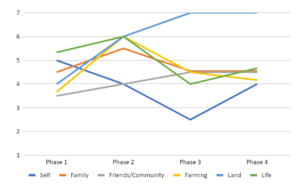
Business outcomes
Josh and Peri have entered into a lease-to-buy arrangement, which will allow them to acquire the property over time without taking on high levels of debt. This requires sufficient levels of profitability in order to service the purchasing arrangement.
The business had a challenging year in 2019-20, with planned one-off infrastructure costs combined with an unprecedented drought, hail damage to the crop, and COVID19 impacts on direct marketing sales. The business recorded a loss of $244,000 in this year. However, the next year costs reduced slightly and trading income increased sixfold, delivering an overall profit of $278,000. While data is limited to these two years, the trend is positive.
It is important to note that the broader case study covers a longer time period, during which the McIntoshes have implemented a range of innovative organic and regenerative production strategies focused on soil health, and begun to access new high value and diversified products, especially organic grain. Many of these will take some time for their full value to become evident.
Figure 6. Border Park Organics EBIT figures for 2019/20 and 2020/21. Source: Vanguard Business Services.
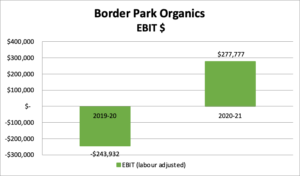
Production output and quality outcomes
The main enterprises at Border Park Organics continue to be cropping, sheep and cattle. Levels of production are variable, as Josh suggests ‘anything from 1000 tonnes of grain to nothing, depending how the season goes’, with 300-400 breeding ewes and 25-40 breeding cattle. The McIntoshs shift their ratio between cropping and animals to suit conditions, and for the long term they recognise there are more opportunities with cropping on their farm, especially when matched with the improvements to soil health that they have been making and the long-term potential of this. Wheat is still the highest yield and income from cereals; however, they are looking at market changes and different customer demands, and trying to diversify where possible.
One of the concerns the McIntoshs brought into a benchmarking process they undertook in 2020 related to the balance of animal dynamics and cropping on their property. Josh and Peri felt they needed to even-up their enterprises given the immediate pressures of drought when their cropping enterprises did not perform. They went into the consultation to identify ways to do this. Working with a business consultant gave them the opportunity to explore profit drivers, their optimal enterprise mix/ratio, and to consider where they need to spend money to be viable. Through the comprehensive analysis it became clear that cropping is still their best bet by a substantial margin, irrespective of temporary fluctuations such as the price of organic grain, shifts in land value and weather patterns.
The results supported their developing vision for the long-term viability of operations, which included incorporating the practice changes they were in the process of making:
What really came out of that benchmarking was a spark of hope that even though things were tough and we were wondering, “Are we even doing the right thing? Are we on the right track for it to show up in the financial statements at least”, that it was worth pursuing, that it almost gave us renewed hope or a willingness to then think, “Okay, well if that is right, then how can we move forward in that vein?”
The overall positive outlook from the consultation gave them greater confidence in continuing with farming after living through a very tough period.
The McIntoshs are committed to fostering stronger consumer connections between food production and nutrition. Peri and Josh both appreciate ‘the idea of people being connected to their food and having confidence in their ability to source their food’. Peri is instrumental in this aspect of management at Border Park Organics. Along with home-schooling seven children and contributing to farm operations, Peri is growing her own small business enterprise, working as a nutritional coach and advisor to support busy parents to cook nutrient-dense, delicious food. Reflecting on the COVID-19 pandemic, the McIntoshs believe that this event pushed people to revisit older practices in terms of cooking, eating and building local community. From their perspective, one of the positive impacts of the pandemic was the way it brought families and communities together and in many cases, re-focused attention on locally grown, healthy produce.
Like many regenerative farmers, the McIntoshs are interested in the potential for new markets where they can sell better-quality, nutrient-dense grain. Nutrient density of food is an important potential outcome of farming in healthy, functional soil. However, the role of regenerative farming practices and the impact that the soil health and farming methods has on the overall nutrition content has not been widely documented or widely engaged within the Australian landscape. Recognising this, Josh and Peri have participated in a pilot nutritional study into the nutrient content of various grain samples at Border Park Organics – stay tuned for further information on this pilot study.
Appendices - Soil test results
Appendix A. Border Park Organics Agricultural Soil Results
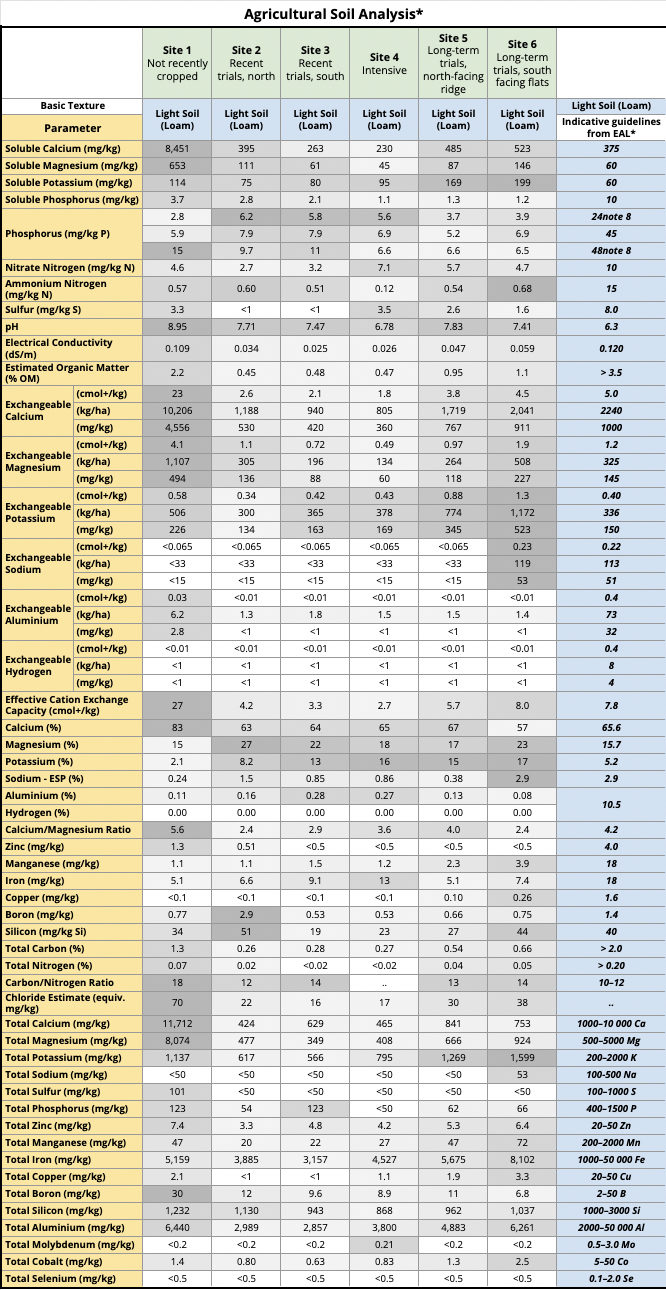
Appendix B. Border Park Organics Haney Soil Health Results
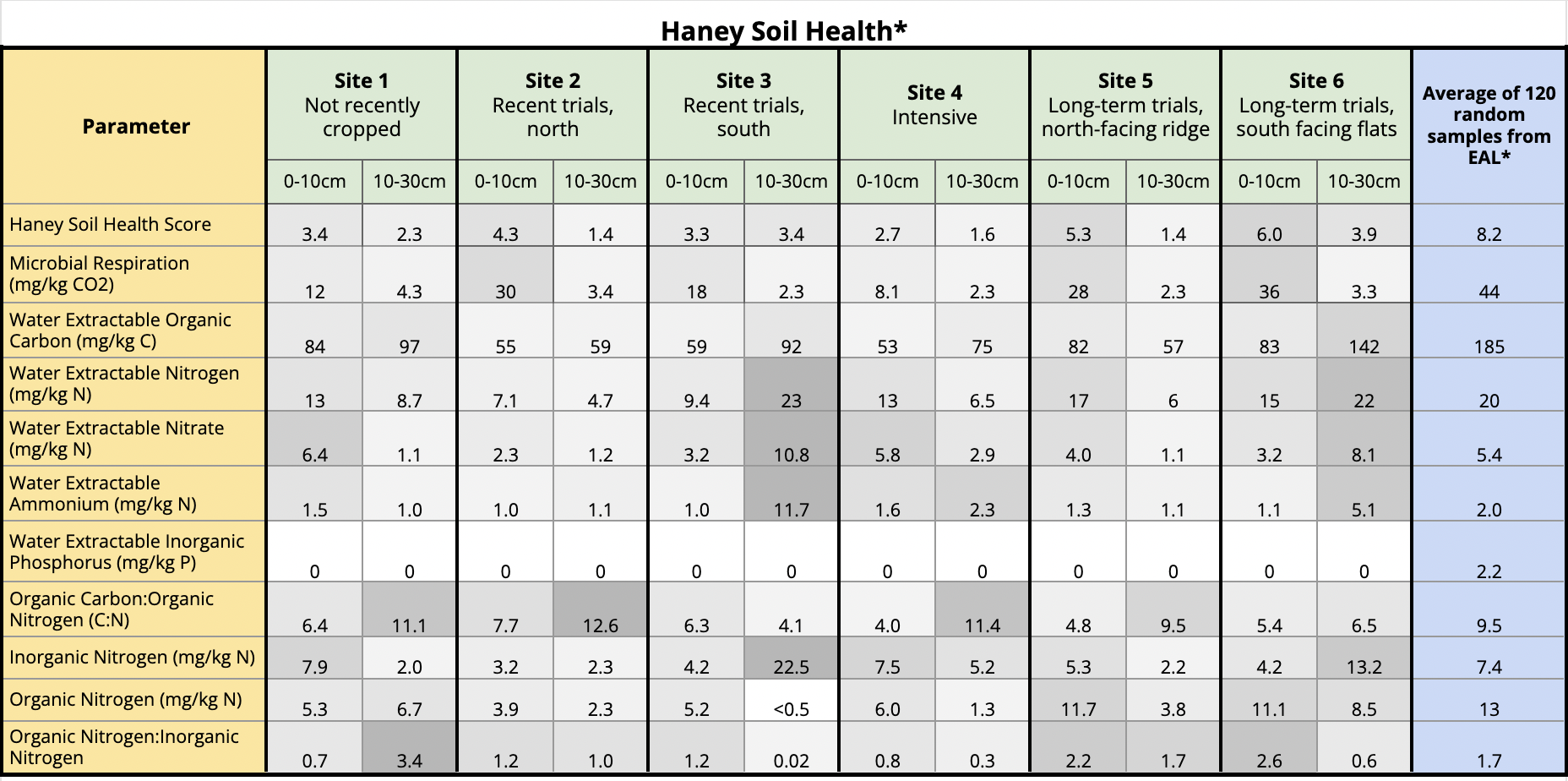
Appendix C. Border Park Organics Soil Foodweb Institute Results
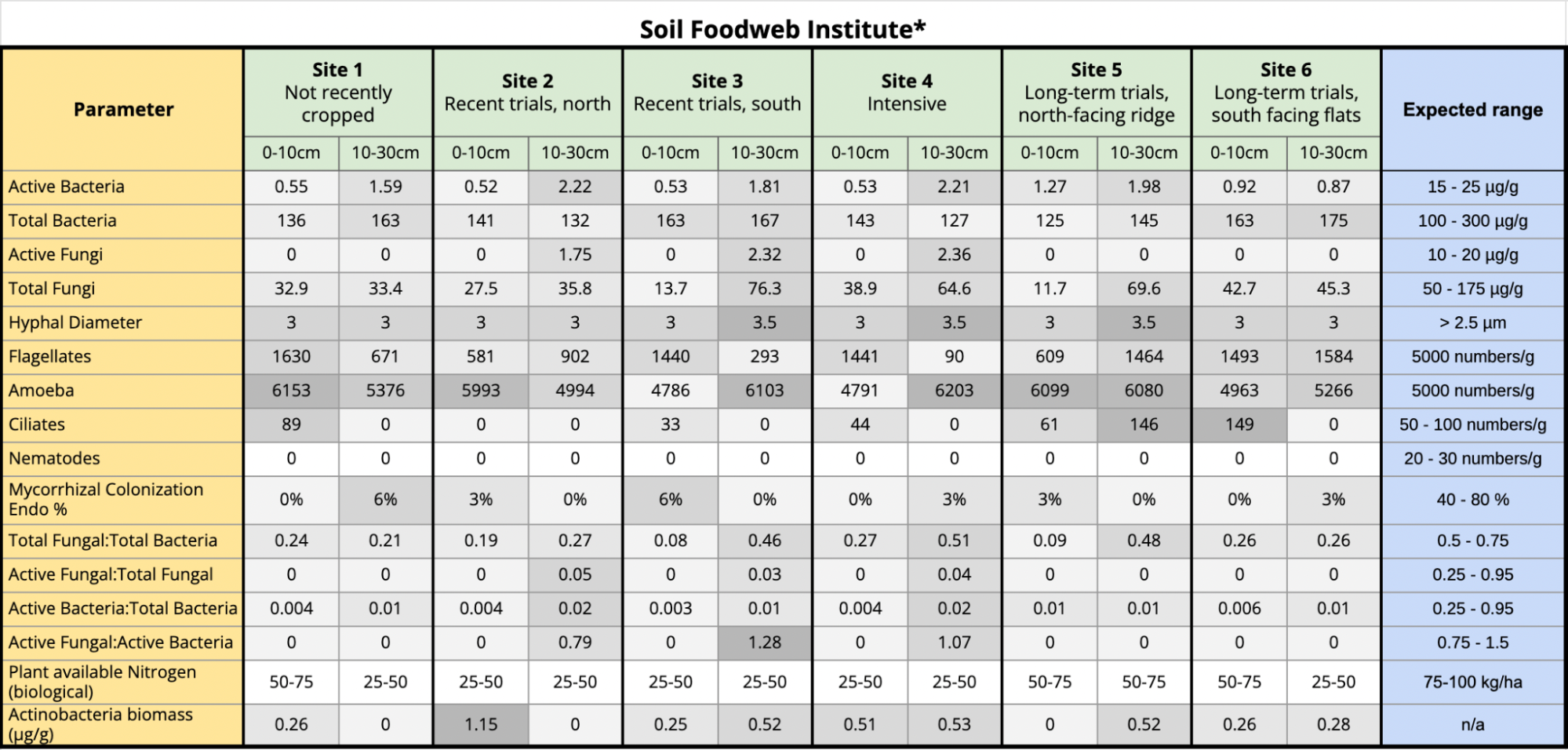
* More detail on Soil Foodweb Institute Australia’s tests here.
Appendix A, B & C: Each row of results has been coloured using a grey scale, where the lightest colour is the lowest number and the darkest colour is the highest number in the row. Colour coding does NOT indicate positive or negative results, and is merely provided to allow simple visual comparison of the numbers in each row.
References
Australian Centre on Quality of Life (2020) Personal Wellbeing Index. Retrieved from <https://www.acqol.com.au/instruments#measures>.
Brown K, Schirmer J and Upton P (2021) ‘Regenerative farming and human wellbeing: Are subjective wellbeing measures useful indicators for sustainable farming systems?’ Environmental and Sustainability Indicators, 11(100132): https://doi.org/10.1016/j.indic.2021.100132
Isbell RF and the National Committee on Soil and Terrain (NCST) (2021) The Australian Soil Classification (Third edit). CSIRO Publishing, Melbourne.
Masters N (2019) For the Love of Soil: Strategies to Regenerate our Food Production System, Integrity Soils, USA.
Regional Wellbeing Survey (RWS) (2020) The University of Canberra. Retrieved from <https://www.regionalwellbeing.org.au/project/regional-wellbeing-survey-user-guide/>.
Schirmer J, Yabsley B, Mylek M, and Peel D (2016) ‘Wellbeing, resilience and liveability in regional Australia: The 2015 Regional Wellbeing Survey’, University of Canberra, Canberra.
Full Reports
External Links
Your Questions
Do you have questions or feedback? We’d love to know more about you and your needs around our case study reports, get in touch.
To hear the latest, follow us on social media or subscribe to our newsletter.
This project is supported by the Australian Government’s Smart Farms Program.




